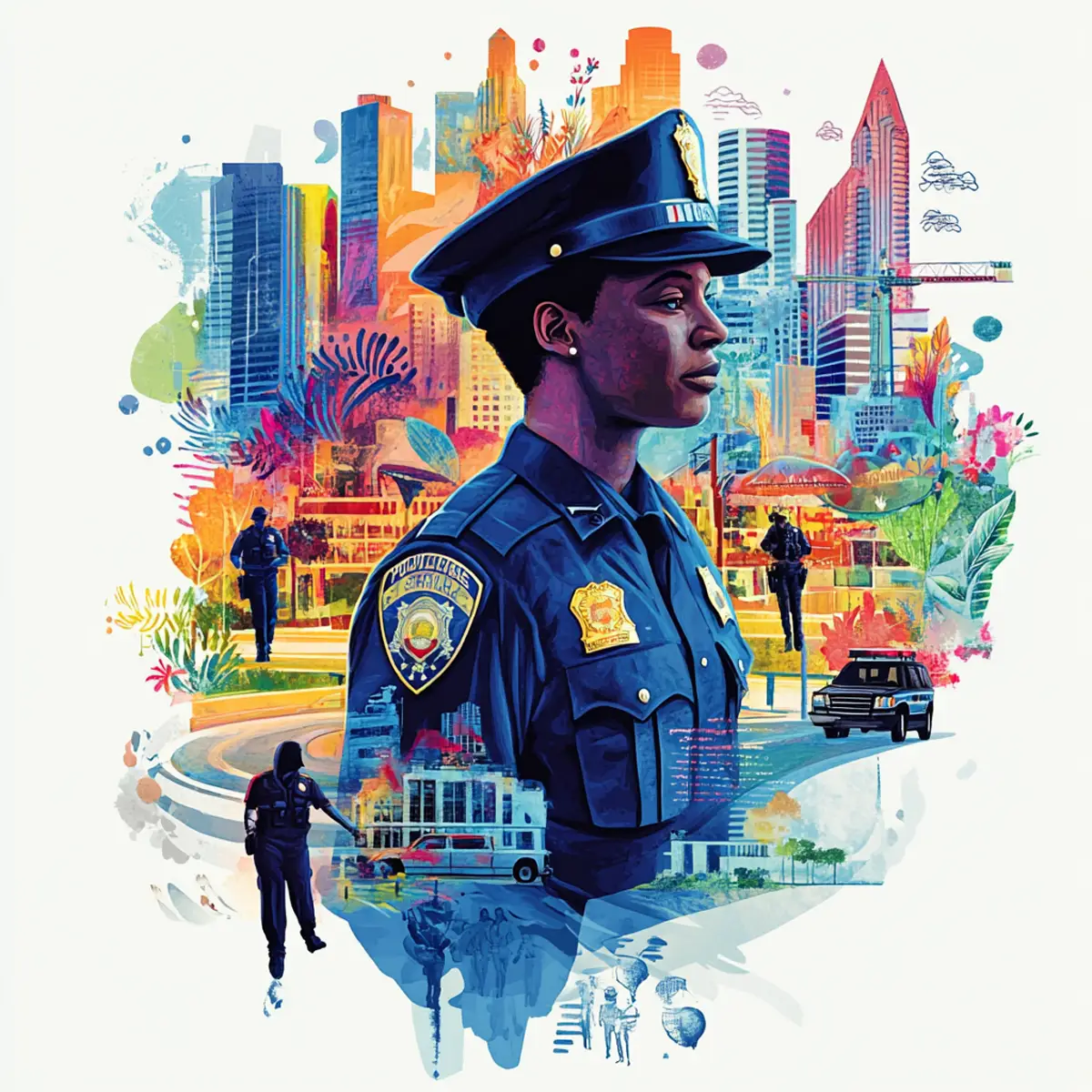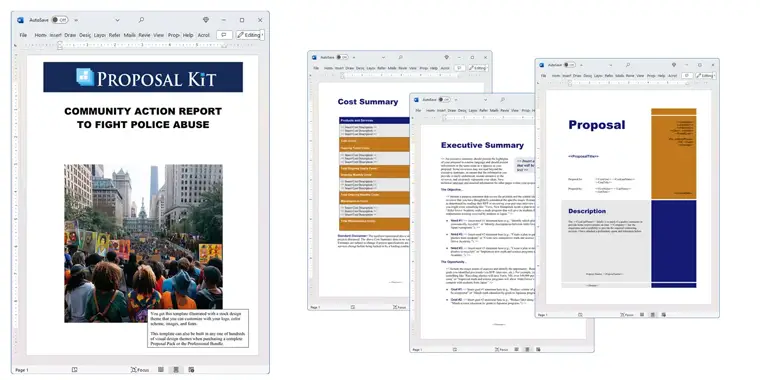How to write your Community Action Report to Fight Police Abuse
We include this 21 page layout with every Proposal Pack. If you want this template to have a different visual design theme than the one illustrated here, purchase any Proposal Pack design and create this template using the purchased design theme. This template is included in every Proposal Pack. If you get a Proposal Pack or the Professional, you can also make any variation of this template with different chapters to suit your needs.
We typically include more chapters in the templates than most people will need to give everyone more variety in the chapters they may need. You can trim down a long template by removing pages you do not need or combining multiple chapter topics into one page.
 DOWNLOADABLE, ONE-TIME COST, NO SUBSCRIPTION FEES
DOWNLOADABLE, ONE-TIME COST, NO SUBSCRIPTION FEESYou can also create countless variations of this document to suit your needs using the included library of 2200+ chapters if ordering a Proposal Pack or Professional.
 What Our Clients Say
What Our Clients SayGreat application that assists in providing me with the direction and the foundation for which I can build upon to develop my business proposals."
Related Article
Related Video
Related Templates
- Political Action Proposal
- Police Reform Program Proposal
- Case Study Report
- Domestic Violence Support Program Funding Proposal
- Awareness and Sensitivity Training in the Workplace Proposal
- Police Reform and Reallocation Proposal
- Fighting Discrimination Funding Proposal
Writing a Community Action Report to Combat Police Abuse with Proposal Kit
In tackling the crucial issue of police abuse within local communities, the question arises: What is a proven way to write a community action report to fight this pressing problem? The Proposal Kit is invaluable for those unfamiliar with report and proposal writing. This software and template library offers a streamlined approach to creating detailed, impactful reports and proposals. Unlike a traditional business proposal, a community action report addresses social issues by outlining actionable steps and strategies. Proposal Kit excels in this domain, offering templates that cover a wide range of topics, from outlining the issues and facts to detailing goals, community concerns, and actionable items such as training, education, strategies, and legislative proposals.
Proposal Kit writes reports, manuals, and other business documents besides just proposals.
If you need to write a document to address any of these issues or a related project, the Proposal Kit could be the solution you're looking for.
What Types of Projects Are Community Action Report to Fight Police Abuses Written For?
Community action reports to address police abuse can vary widely in scope and focus. Here are ten examples of projects that could benefit from such reports:
- Development of community oversight committees.
- Training programs for law enforcement on racial bias and de-escalation.
- Public awareness campaigns on citizens' rights.
- Policy reform initiatives at the local government level.
- Community policing strategy implementations.
- Research projects on the impacts of police abuse.
- Youth outreach programs to build trust between law enforcement and communities.
- Legal assistance funds for victims of police abuse.
- Workshops for law enforcement on mental health and homelessness.
- Community forums for open dialogue between police officers and residents.
Chapters this template is built with
Proposal Kit's comprehensive library includes thousands of template topics, allowing you to customize your report to cover all necessary aspects. Here's how some of the available chapter templates can be utilized for a community action report on police abuse:
Introduction
This section should initiate the conversation by highlighting the critical nature of police abuse in society. It sets the scene by providing a compelling rationale for why this issue demands immediate attention and action. By drawing upon recent events, ongoing societal debates, and the broader implications of police misconduct, the introduction should resonate with the reader's sense of justice and community welfare, establishing the report as a document and a call to action.
Problem Statement
The problem statement digs deeper into the specifics of police abuse, painting a vivid picture of its impact on the community. Here, data intersects with human stories to create a powerful narrative. Statistics on incidents of abuse, discriminatory practices, and the outcomes of such encounters provide the quantitative backbone, while personal anecdotes and testimonies bring a human element that can't be ignored. Together, they underscore the urgency of addressing the issue.
Preface
In the preface, the authors outline the report's blueprint, summarizing the goals and the methodology employed to achieve them. This section is a roadmap for the reader, detailing what the report aims to accomplish and how it plans to get there. It also serves to prime the reader on the report's structure, making it easier to navigate the proposed solutions and recommendations.
Getting Started
This practical section outlines the first steps towards implementing the report's recommendations. Whether rallying community support, initiating dialogues with law enforcement agencies, or lobbying for policy reviews, "Getting Started" is about moving from theory to action. It should provide a straightforward checklist or timeline for the initial phases of the campaign against police abuse.
Goals and Objectives
Here, the report specifies its ambitions, both immediate and long-term. Goals might include increasing awareness of police abuse, reducing incidents of misconduct, or achieving legislative reforms. Objectives would then offer measurable targets to aim for, such as training quotas for officers, community outreach programs, or specific policy changes to be enacted within a given timeframe.
Strategy
The strategy section is the heart of the plan, detailing the comprehensive approach to combatting police abuse. It should cover the various fronts on which the issue will be addressed: legal, social, educational, and political. Key components include:
- Forming coalitions with advocacy groups.
- Engaging in public awareness campaigns.
- Working closely with policymakers to enact change.
Training
Training proposals for law enforcement are crucial in reforming practices and building trust. This part of the report should outline recommended training programs focused on de-escalation techniques, racial bias, mental health awareness, and community policing principles, specifying how these programs can be integrated into existing police training curriculums.
Licensing
Discuss the potential for introducing or modifying licensing requirements for law enforcement officers. This could involve mandatory continuing education, certification in specific areas of policing, or renewal processes that incorporate performance and conduct reviews.
Facts
This section presents research data and findings to underscore the rationale for the proposed actions. It might include statistics on police violence, racial disparities in policing, the effectiveness of various reform measures, and benchmarks from other jurisdictions that have successfully implemented change.
Legislation
This section suggests concrete legislative reforms to curb police abuse. Recommendations could range from national standards for police conduct, such as the use of body cameras, to more localized issues, like the establishment of civilian review boards.
Oversight
Oversight mechanisms are vital for accountability and transparency. This section proposes structures for community oversight, such as independent review panels or ombudsperson offices, detailing their roles, powers, and how they would interact with existing law enforcement frameworks.
Resources
Identifying the resources required to implement the report's recommendations is critical to its success. This includes estimating costs, determining staffing needs, and identifying potential funding sources through government allocations, grants, or community fundraising.
Community
Emphasizing the pivotal role of community engagement, this section explores how to foster and leverage community support in the fight against police abuse. It could outline plans for town hall meetings, community policing initiatives, or partnerships with local organizations.
Assumptions
Clear articulation of the assumptions underlying the report's analysis ensures transparency and builds trust with the reader. It clarifies the premises on which recommendations are based, acknowledging any limitations or potential areas for further investigation.
Monitoring
A robust monitoring plan is essential to gauge the effectiveness of implemented actions. This plan includes establishing success metrics, periodic review schedules, and feedback mechanisms to ensure ongoing strategy improvement and adaptation.
Summary
This is a concise wrap-up that reiterates the report's key findings, recommended actions, and imperative for change. The summary should leave the reader with a clear understanding of the path forward and their role in making it a reality.
Accreditations
Noting endorsements or accreditations from reputable bodies lends authority and credibility to the report. This could include support from legal experts, human rights organizations, or academic institutions.
Policy Changes
Finally, advocating for specific policy adjustments at both the local and national levels addresses the systemic nature of police abuse. This advocacy should pinpoint the laws and regulations that enable or fail to prevent misconduct and propose targeted reforms. For example, it could call for the revision of use-of-force policies, the implementation of comprehensive racial bias training as a condition of police certification or the enactment of laws that facilitate greater public oversight and accountability of law enforcement agencies. By presenting a clear, actionable plan for legislative change, this section aims to pave the way for substantive improvements in how communities are policed and how officers interact with the people they serve. Highlighting successful case studies where policy changes have led to positive outcomes can also provide a blueprint for replication, offering hope and a concrete path forward in the fight against police abuse.
Use cases for this template
Elena's Community Initiative
Elena's journey began with the realization that her community needed a unified voice to address the longstanding issue of police abuse. Despite feeling overwhelmed by the task ahead, she discovered the Proposal Kit, which guided her through the complex report creation process. She gathered stories and data from her community, ensuring every voice was heard. The Proposal Kit templates helped her organize these insights into a structured report, beginning with a compelling introduction outlining the issue's urgency and a detailed problem statement that painted a vivid picture of the community's experiences.
Elena's report didn't just highlight problems; it offered solutions. Utilizing the Goals and Objectives templates, she outlined a series of achievable reforms, including community policing initiatives and oversight committee proposals. The Strategy section laid a plan for collaborative efforts between the police department and community members, emphasizing training and engagement activities to rebuild trust.
Elena's initiative had a profound impact. Her report catalyzed discussions among local leaders and resulted in the formation of a task force dedicated to implementing her proposed reforms. The clear, organized presentation of issues and solutions made her report a powerful tool for change, illustrating the potential of the Proposal Kit to facilitate meaningful community action.
Mia's Non-Profit Advocacy
Mia faced the challenge of addressing police abuse on a global scale. Representing an international non-profit, she needed to compile a report that would resonate with stakeholders across different countries, each with its unique context regarding law enforcement. The Proposal Kit offered Mia a versatile framework to tackle this complex issue. She used the templates to structure her report, starting with an Introduction highlighting the universal importance of human rights and the role of law enforcement in protecting those rights.
As informed by comprehensive research and case studies, Mia's report suggested international strategies for combating police abuse. These included promoting transparency and accountability through international law, supporting grassroots movements, and advocating for adopting global standards on the use of force. The Legislation and Policy Changes sections proposed specific international agreements and local reforms, tailored to the legal and cultural contexts of different countries.
Once presented to stakeholders, the report received acclaim for its depth, clarity, and actionable recommendations. It was a foundation for the non-profit's advocacy efforts, guiding their work in various countries. Mia's success demonstrated the Proposal Kit's adaptability to a wide range of issues and contexts, proving it an invaluable asset for organizations working toward social justice on a global scale.
Conclusions and Recommendations
The diverse applications and transformative potential of Proposal Kit in addressing police abuse across community, corporate, and international landscapes showcase how structured communication and strategic planning can drive societal change.
Also Known As
This template may also be referred to in different ways or be used in more specialized situations, such as:
- Community Response Plan for Combating Law Enforcement Misconduct
- Local Initiative for Addressing Police Misconduct
- Civic Proposal to Combat Police Brutality
- Public Strategy Document Against Policing Abuse
- Community-Led Blueprint for Police Reform
- Grassroots Action Strategy for Law Enforcement Accountability
- Citizens' Plan to Address Law Enforcement Misconduct
- Local Advocacy Report for Police Integrity
- Community Framework for Responsible Policing
- Civic Agenda to Counteract Police Abuse
Abstract
 Communities across the nation face persistent challenges with police abuse, highlighting the need for robust criminal justice reform. Addressing these critical criminal justice issues requires comprehensive community action reports that engage local police departments and hold law enforcement accountable. Such reports, aided by tools like the Proposal Kit, provide a structured approach to tackle concerns such as excessive force and racial discrimination within police practices. By using templates, these reports outline actionable strategies, from public education initiatives to legislative proposals, fostering a framework for police accountability and equal protection under the law.
Communities across the nation face persistent challenges with police abuse, highlighting the need for robust criminal justice reform. Addressing these critical criminal justice issues requires comprehensive community action reports that engage local police departments and hold law enforcement accountable. Such reports, aided by tools like the Proposal Kit, provide a structured approach to tackle concerns such as excessive force and racial discrimination within police practices. By using templates, these reports outline actionable strategies, from public education initiatives to legislative proposals, fostering a framework for police accountability and equal protection under the law.
Proposal Kit offers indispensable resources for developing reports that address police misconduct at various levels. These reports can drive policy recommendations aimed at the local police department and state and federal agencies, including the Department of Justice and the United States Department of Justice. By investigating allegations of police misconduct, community members can file suits and press for changes that protect civil rights and ensure fair treatment for all, including African Americans and other underrepresented groups.
Collaboration with organizations such as the National Lawyers Guild and the National Association for the Advancement of Colored People (NAACP) amplifies efforts to combat racial discrimination and violent crime. Through public education and community engagement, advocates and politicians can spearhead initiatives that lead to systemic change in police work. By conducting research and gathering citizen complaints, communities can develop effective justice programs that address harassment and retaliation, paving the way for safer communities.
 Training programs for police officials on mental health, de-escalation, and cultural sensitivity are critical in reforming police departments. Establishing oversight mechanisms, like independent review panels and citizens' complaint offices, ensures transparency and builds trust between law enforcement and the community. By focusing on policy changes such as revising the use-of-force policies, introducing new licensing procedures, and enforcing equal protection laws, these reports act as catalysts for change, striving to protect the rights of every person in every city across the country.
Training programs for police officials on mental health, de-escalation, and cultural sensitivity are critical in reforming police departments. Establishing oversight mechanisms, like independent review panels and citizens' complaint offices, ensures transparency and builds trust between law enforcement and the community. By focusing on policy changes such as revising the use-of-force policies, introducing new licensing procedures, and enforcing equal protection laws, these reports act as catalysts for change, striving to protect the rights of every person in every city across the country.
Building on the foundation of community action reports, there is great potential for transformative change in the criminal justice system by addressing systemic violations and promoting police accountability. These reports are important tools for citizens, advocates, and organizations seeking to reform police practices and ensure public safety. The reports often incorporate extensive research on criminal justice reform and involve collaboration with legal experts and advocacy groups such as the National Lawyers Guild. By referencing past incidents and citizen complaints, these documents underscore the pressing need for justice programs that address racial bias and promote civil rights.
Effective community action reports propose establishing oversight mechanisms, such as civilian review boards, to investigate allegations of police misconduct thoroughly. These boards can work alongside the Department of Justice and other federal agencies to ensure accountability and prevent future incidents of excessive force and racial discrimination. Engaging with national associations and community councils helps to foster cooperation between law enforcement and the public, encouraging transparency and open dialogue.
 Moreover, reports emphasize the importance of public education and awareness campaigns to inform citizens about their rights and the responsibilities of law enforcement. By promoting equal protection under the Constitution, these initiatives aim to protect individuals from harassment and discrimination based on race, religion, or other characteristics. Workshops and training sessions for police departments on issues like mental health and homelessness further enhance the dialogue between officers and the communities they serve.
Moreover, reports emphasize the importance of public education and awareness campaigns to inform citizens about their rights and the responsibilities of law enforcement. By promoting equal protection under the Constitution, these initiatives aim to protect individuals from harassment and discrimination based on race, religion, or other characteristics. Workshops and training sessions for police departments on issues like mental health and homelessness further enhance the dialogue between officers and the communities they serve.
Policy recommendations within these reports often call for legislative changes at both local and national levels. These changes may include revising firearms policies, implementing new arrest procedures, and ensuring that police officials are held accountable for any misconduct. By advocating for policy adjustments, communities can address the root causes of crime and discrimination, ultimately leading to a more just and fair society.
In recent years, the importance of such reports has been recognized widely, with politicians and community leaders acknowledging their role in driving systemic reform. Through litigation and action plans, community action reports serve as a blueprint for achieving meaningful change in the criminal justice landscape. By focusing on long-term objectives and fostering a coalition of support, these documents empower citizens to hold their local police departments accountable, ensuring a safer and more equitable future for all.
Frequently Asked Questions
How do I gather reliable data and evidence for the report?
Gathering reliable data and evidence is essential for the credibility of your community action report. Collect information from multiple sources, including official police records, government databases, and independent watchdog organizations. Conduct interviews with victims, witnesses, and experts, and use surveys to gather community input. Ensure all data is thoroughly verified, and cite your sources meticulously. Photographs, videos, and personal testimonies can also provide compelling evidence, but they must be authenticated to avoid discrediting your report.
What structure should I follow when writing the report?
A well-structured report typically includes several essential sections: an executive summary, introduction, methodology, findings, analysis, recommendations, and a conclusion. The executive summary should provide a brief overview of the entire report. The introduction sets the context and objectives. The methodology explains how data was collected and analyzed. The findings present the collected data, while the analysis interprets this data to identify trends and issues. Recommendations offer actionable steps, and the conclusion summarizes the report's main points and calls to action.
How do I ensure that my report is unbiased and objective?
To ensure your report maintains objectivity, present data and evidence without personal bias or emotional language. Focus on factual, verifiable information and provide balanced viewpoints by including perspectives from multiple stakeholders, including law enforcement officials, community leaders, and affected individuals. Peer reviews and consultations with experts can help identify and mitigate any unintentional bias. Transparency in your methodology and clear citation of your sources also enhance the report's credibility and impartiality.
What are effective ways to engage the community in the report-writing process?
Engaging the community is crucial for a comprehensive and representative report. Start by organizing public forums, town hall meetings, and focus groups to gather input and discuss issues. Use social media platforms and community newsletters to reach a broader audience and encourage participation. Surveys, petitions, and collaborative workshops can also be valuable tools for soliciting community feedback. Engaging local organizations and advocacy groups can help amplify voices that might otherwise be underrepresented.
How do I present my findings and recommendations to drive real change?
Presenting findings and recommendations in a and actionable manner is key to driving change. Use clear, concise language and support your points with strong evidence and data visualizations like charts and graphs. Tailor your recommendations to be specific, realistic, and actionable, outlining concrete steps for implementation. Engage with local media, policymakers, and community leaders to disseminate your report and advocate for its recommendations. Follow up with stakeholders to maintain momentum and track progress on enacted changes.
20% Off Discount
![]() Add To Cart This Word Template
Add To Cart This Word Template
 Add To Cart Proposal Pack for Any Business
Add To Cart Proposal Pack for Any Business
 Add To Cart Proposal Kit Professional
Add To Cart Proposal Kit Professional
 4.7 stars, based on 849 reviews
4.7 stars, based on 849 reviewsProposal Kit chapters used in this template
Title Page, Table of Contents, Introduction, Preface, Assumptions, Getting Started, Problem Statement, Facts, Community, Goals and Objectives, Training, Oversight, Policy Changes, Licensing, Accreditations, Strategy, Monitoring, Legislation, Summary, Resources, Back Page
You use this proposal for
- Non-government grant, non-profit, NGO proposal
- Business document, study, plan, report
How to create this template with Proposal Pack Wizard
You can create this document using any of the logo-designed Proposal Packs. Pick any Proposal Pack with a logo design theme you like best; they will all work equally well. The Proposal Pack for Any Business is the pack with no extra added logos or colors - designed to be used plain or for you to customize with your logos and graphics.
The Proposal Pack design theme you purchase will determine the visual look of this template. The screenshot above only shows the plain generic design theme.
We include a library of chapters to be assembled based on your needs. All proposals are different and have different needs and goals. We designed Proposal Pack so you can customize the documents to suit your needs.
You will best create this document using the Proposal Pack Wizard - Expert Edition software to select this template and build it in the Proposal Pack logo design theme of your choice along with any desired customizations (such as adding additional chapters, removing unneeded chapters, changing the order of chapters, and importing your company logo). This template outlines a proposal for the described situation. Each user is responsible for typing in the actual content of the provided pages with their information to complete the proposal. Suggestions in the abstract may include features in higher-end packages and are facilitated by the selection of chapter templates to support the narrative of each proposal, which help guide the user in filling in the details.
The Wizard software's AI Writer will write the content of the pages of the template based on details provided for your company, client, project, financial details and other writing instructions. This will provide a personalized version of the template completely written and ready to edit.
Once finished, the AI Writer's Word-to-PowerPoint converter can transform your proposal, business plan, or other business documents into a PowerPoint slideshow. Save time and effort by letting the AI analyze every chapter to condense its content into talking points, visually matching the document, and providing a consistent package of presentation material with the click of a button.
You create this template using the Wizard software with an entire Proposal Pack library and software. We include the Expert Edition of the software in the Proposal Kit Professional. Microsoft Word for Windows is required to use the customizing software. You can also edit Word document templates in other office software such as Word for Mac. We will assist Mac users in assembling complex templates for their first project if they do not have the required platform to run the Wizard software.
How to Build Templates Featured on Proposal Kit Website
Many people find the Proposal Kit website after searching for a specific proposal. Once you've purchased and installed the software, how do you build that template you found in the first place? This video shows you how to build any proposal you see on the Proposal Kit website.
 Ian Lauder has been helping businesses write their proposals and contracts for two decades. Ian is the owner and founder of Proposal Kit, one of the original sources of business proposal and contract software products started in 1997.
Ian Lauder has been helping businesses write their proposals and contracts for two decades. Ian is the owner and founder of Proposal Kit, one of the original sources of business proposal and contract software products started in 1997.By Ian Lauder
 Published by Proposal Kit, Inc.
Published by Proposal Kit, Inc.


 Cart
Cart
 Get 20% off ordering today:
Get 20% off ordering today: 


 Facebook
Facebook YouTube
YouTube Bluesky
Bluesky Search Site
Search Site